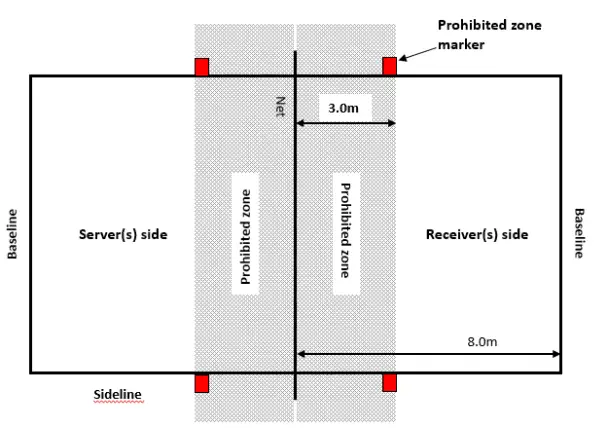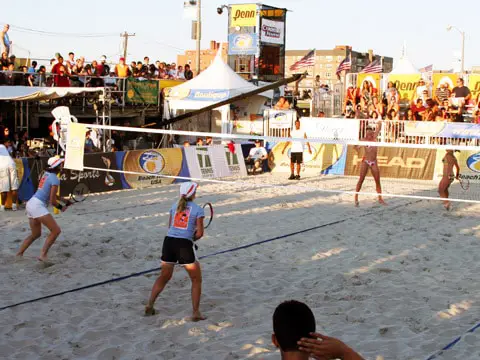As amazing as a game of beach tennis sounds, the International Tennis Federation has an exhaustive set of rules of regulations around this sport. If you want to understand how to play beach tennis, here’s a comprehensive guide on the beach tennis rules.
Beach tennis is a sport that, as the name obviously suggests, is played at a beach, and is based on tennis, with traces of volleyball in it. And with that basic definition of beach tennis out of the way, let’s dig right into what we promised you earlier.
Table of Content
What are the Beach Tennis Rules?
The basic guidelines behind how to play beach tennis include the following. We will explain each of these in detail below as well.
- Court width is different for singles (4.5 meters) and doubles (8 meters). The length for both remains the same at 16 meters.
- Net height is 1.7 meters
- Stage 2 (low compression orange) balls
- Non-stringed racket with maximum length and width of 55 cm X 30 cm
- Best of three sets, need to win six games with a difference of two to win a set. Else tie-breaker
- Point system has love, 15, 30, 40 and deuce like normal tennis. Winner of next point after deuce wins game
- Either receiver of serve can return a server’s serve in doubles.
- Receivers can stand anywhere inside or outside the lines on the receiver’s end
- Ball touching the line implies ball’s inside the court bounded by that line
- Serves will be alternated every other game between the two teams and every player will serve once every four games in a set
- No second service allowed, i.e. in case of a fault, the point is won by the opposition
- Unlike in tennis, there are no lets in beach tennis.
Now let’s dive deeper into these basic guidelines for the beach tennis rules.
As mentioned earlier, the ITF look after the sport of beach tennis, much like they do tennis, and in turn, also govern the rules and regulations of beach tennis.
In order to do so, they have a Beach Tennis Committee that acts as the eyes and ears of the sport world over but more vitally are in charge of the rules and regulations.
If needed, this Beach Tennis Committee makes recommendations to tweak any of the sport to the Rules of Tennis Committee who then gets in direct touch with the ITF Board of Directors of the ITF to do the same. Here’re the Beach Tennis rules explained in depth.
Also Read:
Court and Playing Surface
Beach Tennis has a rectangular court, much like the normal tennis, with singles matches to be played to a width of 4.5 meters and doubles matches to 8 meters. The length of the court remains at 16 meters long for both singles and doubles.
The net used to divide the court is at the middle at a minimum height of 1.7 meters.
The court lines will be between 2.5-5 cm wide, except the baseline which can be up to 10 cm wide. If these lines are moved during play, they should be brought back to their original position before play resumes.
As far as the playing surface is concerned, it should be levelled sand, and should be free of any objects which could end up hurting the players.
Beach Tennis Ball
The ball used in Beach Tennis is the Stage 2, low-compression orange ball which can weigh between 36 and 46.9 grams, with a diameter of 6 to 6.86 cm. Some of the other specifications include the following:
- REBOUND: 105-120 cm
- FORWARD DEFORMATION: 1.40-1.65 cm
Ball changes will be made throughout the match, after a pre-decided number of odd games. In case the ball gets broken during play, the point will need to be replayed after a change in the ball.
Beach Tennis Racket
A Beach Tennis racket’s hitting surface shouldn’t be more than 30 cm in length and 26 cm in width. Its total length shouldn’t exceed more than 50 cm, which is the length from one end of the handle to the outer-most tip of the head. The racket thickness shouldn’t be more than 38 mm.
A racket shouldn’t be attached with any communication device. Players need to obviously play with just one racket at any given time, and cannot used a stringed racket at any point.
Also Read:
Beach Tennis Scoring
The scoring is not too different from normal tennis, with matches played over best of three sets and each set won by a player who wins six games with a difference of two.
If a set reaches six games all, a tie-breaker is played with the first player or team to reach seven points with a difference of two winning it.
While the scoring in a game is not too different from a normal tennis game in which scores of love, 15, 30 and 40 are used, there is no concept of Advantage after Deuce; i.e. the player or team winning the point after Deuce, wins the game.
Serving & Receiving
While the singles serving and receiving happens in the same way as in normal tennis, what’s different is how the serving happens in doubles beach tennis.
The server can serve to anywhere on the court, and either of the opponent players can return the serve. Members of the receiving doubles team can stand outside the baseline or sidelines too.
While players can hit the ball by transgressing on the invisible area above the net belonging to the opposition, they cannot step on the opponent’s playing area.
Players can move forward to block a serve but without causing hindrance to the opponent, the ball has crossed the net, and the receiver doesn’t touch any part of the Prohibited Service Return Zone until the ball is in play from the server’s side.

What is the Prohibited Zone in Beach Tennis?
The Prohibited Zone in Beach Tennis is like the Kitchen in Pickleball. The difference between the two, however, is stark with the Prohibited Zone coming into play only before the serve.
The receivers of the serve in beach tennis cannot move into the Prohibited Zone before the ball is in play. This rule has been introduced to prevent points from finishing as soon as the serve is made with the receivers volleying it back at the net.
Game Play in Beach Tennis
Ends are changed after first, third and every odd game of all sets. In the tie-breaker ends are changed after the first point and then, every four points after that.
Ball remains in play unless a fault or let is called or until the point is decided. If a ball touches the line, it is considered to be inside the court, while if a ball touches the net post, the player or team hitting it there loses the point.
The server will have to remain behind the baseline and within the sideline, and the service is completed when the serving motion is complete irrespective of whether or not the server hits the ball or misses.
There are no second services in Beach Tennis, and in Mixed Doubles, the male player needs to serve underarm.
A foot fault is called out if a server changes position by walking or running during the serve or touches either the baseline or the sideline while doing so. However, a server is allowed to jump up while serving.
In case any of these serving rules are broken, it is called a Fault and the opponent wins the point.
There are no lets during service but a let will be called if the ball gets broken during play, or a member of the receiving team isn’t ready or if some line on the playing surface comes loose.
Where to Find the Exact Rules and Regulations of Beach Tennis?
The ITF, which is also the governing body of competitive tennis around the world, has a comprehensive guide on the rules of beach tennis which is available in different languages (English, Spanish and French) here.
You can also look to understand the rules of Headis here and pickleball rules here.


